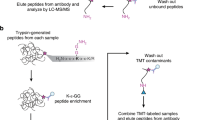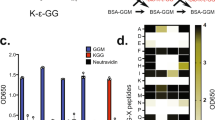Abstract
The small ubiquitin-like modifier (SUMO) is a protein modifier that is post-translationally coupled to thousands of lysines in more than a thousand proteins. An understanding of which lysines are modified by SUMO is critical in unraveling its function as a master regulator of all nuclear processes, as well as its involvement in diseases such as cancer. Here we describe a protocol for the lysine-deficient (K0) method for efficient identification of SUMOylated lysines by mass spectrometry (MS). To our knowledge, the K0 method is the only currently available method that can routinely identify >1,000 SUMO sites in mammalian cells under standard growth conditions. The K0 strategy relies on introducing a His10-tagged SUMO wherein all lysines have been substituted to arginines. Lysine deficiency renders the SUMO immune to digestion by the endoproteinase Lys-C, which in turn allows for stringent and high-yield tandem purification through the His10 tag. In addition, the His10-tagged SUMO also contains a C-terminal Q87R mutation, which accommodates generation of SUMO-site peptides with a QQTGG mass remnant after digestion with trypsin. This remnant possesses a unique mass signature and readily generates diagnostic ions in the fragment ion scans, which increases SUMO-site identification confidence. The K0 method can be applied in any mammalian cell line or in any model system that allows for integration of the K0-SUMO construct. From the moment of cell lysis, the K0 method takes ∼7 d to perform.
This is a preview of subscription content, access via your institution
Access options
Subscribe to this journal
Receive 12 print issues and online access
$259.00 per year
only $21.58 per issue
Buy this article
- Purchase on Springer Link
- Instant access to full article PDF
Prices may be subject to local taxes which are calculated during checkout




Similar content being viewed by others
References
Hendriks, I.A. et al. Uncovering global SUMOylation signaling networks in a site-specific manner. Nat. Struct. Mol. Biol. 21, 927–936 (2014).
Dasso, M. Emerging roles of the SUMO pathway in mitosis. Cell Div. 3, 5 (2008).
Jackson, S.P. & Durocher, D. Regulation of DNA damage responses by ubiquitin and SUMO. Mol. Cell 49, 795–807 (2013).
Eckermann, K. SUMO and Parkinson's disease. Neuromolecular. Med. 15, 737–759 (2013).
Flotho, A. & Melchior, F. Sumoylation: a regulatory protein modification in health and disease. Annu. Rev. Biochem. 82, 357–385 (2013).
Lee, L., Sakurai, M., Matsuzaki, S., Arancio, O. & Fraser, P. SUMO and Alzheimer's disease. Neuromolecular. Med. 15, 720–736 (2013).
Becker, J. et al. Detecting endogenous SUMO targets in mammalian cells and tissues. Nat. Struct. Mol. Biol. 20, 525–531 (2013).
Impens, F., Radoshevich, L., Cossart, P. & Ribet, D. Mapping of SUMO sites and analysis of SUMOylation changes induced by external stimuli. Proc. Natl. Acad. Sci. USA 111, 12432–12437 (2014).
Bernier-Villamor, V., Sampson, D.A., Matunis, M.J. & Lima, C.D. Structural basis for E2-mediated SUMO conjugation revealed by a complex between ubiquitin-conjugating enzyme Ubc9 and RanGAP1. Cell 108, 345–356 (2002).
Johnson, E.S. Protein modification by SUMO. Annu. Rev. Biochem. 73, 355–382 (2004).
Ulrich, H.D. The fast-growing business of SUMO chains. Mol. Cell 32, 301–305 (2008).
Guzzo, C.M. et al. RNF4-dependent hybrid SUMO-ubiquitin chains are signals for RAP80 and thereby mediate the recruitment of BRCA1 to sites of DNA damage. Sci. Signal. 5, ra88 (2012).
Hay, R.T. SUMO-specific proteases: a twist in the tail. Trends Cell Biol. 17, 370–376 (2007).
Mann, M. & Jensen, O.N. Proteomic analysis of post-translational modifications. Nat. Biotechnol. 21, 255–261 (2003).
Eifler, K. & Vertegaal, A.C. Mapping the SUMOylated landscape. FEBS J. (2015).
Denison, C. et al. A proteomic strategy for gaining insights into protein sumoylation in yeast. Mol. Cell. Proteomics 4, 246–254 (2005).
Tammsalu, T. et al. Proteome-wide identification of SUMO2 modification sites. Sci. Signal. 7, rs2 (2014).
Lamoliatte, F. et al. Large-scale analysis of lysine SUMOylation by SUMO remnant immunoaffinity profiling. Nat. Commun. 5, 5409 (2014).
Hendriks, I.A., D'Souza, R.C., Chang, J.G., Mann, M. & Vertegaal, A.C. System-wide identification of wild-type SUMO-2 conjugation sites. Nat. Commun. 6, 7289 (2015).
Matic, I. et al. Site-specific identification of SUMO-2 targets in cells reveals an inverted SUMOylation motif and a hydrophobic cluster SUMOylation motif. Mol. Cell 39, 641–652 (2010).
Xiao, Z. et al. System-wide analysis of SUMOylation dynamics in response to replication stress reveals novel SUMO target proteins and acceptor lysines relevant for genome stability. Mol. Cell. Proteomics. 14, 1419–1434 (2015).
Hendriks, I.A., Treffers, L.W., Verlaan-de Vries, M., Olsen, J.V. & Vertegaal, A.C. SUMO-2 orchestrates chromatin modifiers in response to DNA damage. Cell Rep. 10, 1778–1791 (2015).
Knuesel, M., Cheung, H.T., Hamady, M., Barthel, K.K. & Liu, X. A method of mapping protein sumoylation sites by mass spectrometry using a modified small ubiquitin-like modifier 1 (SUMO-1) and a computational program. Mol. Cell Proteomics 4, 1626–1636 (2005).
Wohlschlegel, J.A. Identification of SUMO-conjugated proteins and their SUMO attachment sites using proteomic mass spectrometry. Methods Mol. Biol. 497, 33–49 (2009).
Bylebyl, G.R., Belichenko, I. & Johnson, E.S. The SUMO isopeptidase Ulp2 prevents accumulation of SUMO chains in yeast. J. Biol. Chem. 278, 44113–44120 (2003).
Wohlschlegel, J.A., Johnson, E.S., Reed, S.I. & Yates, J.R. III Improved identification of SUMO attachment sites using C-terminal SUMO mutants and tailored protease digestion strategies. J. Proteome. Res. 5, 761–770 (2006).
Bruderer, R. et al. Purification and identification of endogenous polySUMO conjugates. EMBO Rep. 12, 142–148 (2011).
Barysch, S.V., Dittner, C., Flotho, A., Becker, J. & Melchior, F. Identification and analysis of endogenous SUMO1 and SUMO2/3 targets in mammalian cells and tissues using monoclonal antibodies. Nat. Protoc. 9, 896–909 (2014).
Cubenas-Potts, C. et al. Identification of SUMO-2/3-modified proteins associated with mitotic chromosomes. Proteomics 15, 763–772 (2015).
Tammsalu, T. et al. Proteome-wide identification of SUMO modification sites by mass spectrometry. Nat. Protoc. 10, 1374–1388 (2015).
Rappsilber, J., Mann, M. & Ishihama, Y. Protocol for micro-purification, enrichment, pre-fractionation and storage of peptides for proteomics using StageTips. Nat. Protoc. 2, 1896–1906 (2007).
Cox, J. et al. Andromeda: a peptide search engine integrated into the MaxQuant environment. J. Proteome. Res. 10, 1794–1805 (2011).
Cox, J. & Mann, M. MaxQuant enables high peptide identification rates, individualized p.p.b.-range mass accuracies and proteome-wide protein quantification. Nat. Biotechnol. 26, 1367–1372 (2008).
Tiscornia, G., Singer, O. & Verma, I.M. Production and purification of lentiviral vectors. Nat. Protoc. 1, 241–245 (2006).
Stacey, G.N. & Masters, J.R. Cryopreservation and banking of mammalian cell lines. Nat. Protoc. 3, 1981–1989 (2008).
Acknowledgements
We are grateful for support from the European Research Council (grant 310913 to A.C.O.V.) and the Netherlands Organization for Scientific Research (NWO; grant 700.59.006 to A.C.O.V.). We acknowledge R.C.J. D'Souza, B. Yang and M. Mann for assistance with the initial optimization of the MS methodology.
Author information
Authors and Affiliations
Contributions
I.A.H. generated cell lines, optimized the entire purification method, created biological samples, optimized the MS procedure, performed MS data analysis and conducted bioinformatics analysis. A.C.O.V. conceived the method and supervised the project. I.A.H. and A.C.O.V. wrote the manuscript.
Corresponding author
Ethics declarations
Competing interests
The authors declare no competing financial interests.
Integrated supplementary information
Supplementary Figure 1 QQTGG and pyroQQTGG variable modifications
Screenshot of the QQTGG and pyroQQTGG (PyroQ) variable modifications as displayed in the Andromeda software.
Supplementary information
Supplementary Text and Figures
Supplementary Figure 1 and Supplementary Note (PDF 258 kb)
Rights and permissions
About this article
Cite this article
Hendriks, I., Vertegaal, A. A high-yield double-purification proteomics strategy for the identification of SUMO sites. Nat Protoc 11, 1630–1649 (2016). https://doi.org/10.1038/nprot.2016.082
Published:
Issue Date:
DOI: https://doi.org/10.1038/nprot.2016.082
This article is cited by
-
Hypoxia-driven deSUMOylation of EXOSC10 promotes adaptive changes in the transcriptome profile
Cellular and Molecular Life Sciences (2024)
-
Crosstalk between SUMOylation and ubiquitylation controls DNA end resection by maintaining MRE11 homeostasis on chromatin
Nature Communications (2022)
-
Identification of proximal SUMO-dependent interactors using SUMO-ID
Nature Communications (2021)
-
Proteomic strategies for characterizing ubiquitin-like modifications
Nature Reviews Methods Primers (2021)
-
The poly-SUMO2/3 protease SENP6 enables assembly of the constitutive centromere-associated network by group deSUMOylation
Nature Communications (2019)
Comments
By submitting a comment you agree to abide by our Terms and Community Guidelines. If you find something abusive or that does not comply with our terms or guidelines please flag it as inappropriate.



